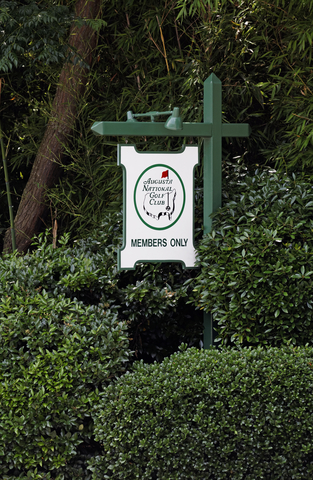
Since 1934, the Masters has been played annually at the Augusta National Golf Club. Founded by Clifford Roberts and the legendary golfer Bobby Jones, the duo teamed up with course architect Alister MacKenzie to carve the historic Augusta layout from the grounds of a former plant nursery.
The rich traditions of Augusta
The invitation-only event has numerous traditions that make the tournament one-of-a-kind. First, the winner every year is given a green jacket to wear for one year. When the previous year’s champion returns to Augusta, he must return the jacket to the Club for storage. Past winners who are fortunate enough to win another Masters title must use the same jacket for additional victories.
A Champions’ Dinner is held on the Tuesday of Masters week with the preceding year’s champion choosing the menu for dinner. It is typical for winners to choose meals from their home country. For example, England’s Nick Faldo chose fish and chips to represent a staple food combination from his birthplace.
Another favorite tradition that first began in 1960 is a par-3 contest that is played on the par-3 course at Augusta. Measuring just 1,060 yards across the nine holes, the par-3 contest is known for crowd-pleasing hole-in-ones from a variety of current and former Masters winners. The family-friendly par-3 tournament is typically held on the Wednesday before the first round begins the following day.
Before the tournament officially begins, tradition calls for an honorary opening tee shot at Augusta. Since 1963, crowds have gathered in the early hours of Thursday to watch one or more of golf’s legends officially open the Masters with a shot off the tee box. Golfers that have provided the customary opener include Sam Snead, Byron Nelson, Gene Sarazen, Arnold Palmer, Gary Player and Jack Nicklaus.
Another distinct feature only seen at Augusta involves the caddies attire on the course. Caddies are required to wear a white jumpsuit with the player’s name across the back. They are also made to wear an official green Masters hat and white tennis shoes.
Augusta’s famous layout
Among the Augusta grounds, there are famous plaques, trees, and cabins that all have a rich and distinctive history. But there are two areas on the course that get the lion’s share of the attention. They are the three-hole stretch known as Amen Corner and Rae’s Creek that runs through the same area and has caused fits for golfers throughout the years.
Amen Corner
A notorious stretch of Augusta National was named “Amen Corner” in a Sports Illustrated article by writer Herbert Warren Wind. After watching Arnold Palmer tame the run of the 11th, 12th, and 13th hole in the 1958 Masters, Wind created the moniker and the nickname stuck throughout the years. Palmer’s win that year at Augusta, due in part to his play through Amen Corner, was his first of seven major titles.
Meltdowns are common on Amen Corner and have cost numerous golfers the opportunity to win a green jacket. Jordan Spieth was in cruise control during the final round of the 2016 Masters and after the turn the Texan had a five-stroke lead on the rest of the field. But then Spieth bogeyed the 10th and 11th hole. Needing to steady his game, Spieth imploded by quadruple bogeying the par-3 12th hole. His lead vanished, and Spieth lost the major due to his catastrophic play at Amen Corner.
Rae’s Creek
The famous body of water that runs in front of the par-3 12th green is known as Rae’s Creek. It runs through the heart of Amen Corner at Augusta National as the creek runs around the rear of the 11th green, in front of the 12th green, along with the 13th fairway and crosses again in front of the 13th green.
Across the section of Rae#s Creek that hugs the 12th hole, a small footbridge allows the golfer to cross the water to the green area. That famous stone bridge is known as the Hogan Bridge, named after Ben Hogan, the legendary golfer who won the 1953 Masters. At the time of the bridge’s dedication, Hogan owned the lowest score for a four-round total with the victory in 1953.
Another famous bridge crosses Rae’s Creek on the 13th hole. Nelson Bridge, named after the golfer Byron Nelson, was dedicated the same day as the Hogan Bridge. Nelson won the 1937 Masters after gaining six strokes on the leader after he passed through Amen Corner.
Here’s a look at some of the most iconic tournaments in the history of the Masters.
Iconic tournaments in Masters history
Jack’s improbable 1986 Masters victory
As the 1986 Masters began, it seemed the game of golf had left behind the legend known as Jack Nicklaus. 46 years of age, Nicklaus’ last major had come six years prior as he won both the PGA Championship and U.S. Open in 1980.
When asked before the tournament by CBS if Nicklaus could win the Masters at age 46, Arnold Palmer told the network, “As a matter of fact… I think (Nicklaus) can still win a golf tournament… you just have to get it all together one time…”
Although Palmer thought Nicklaus had a chance, many considered the Golden Bear to be an afterthought. An opening round 74 for Nicklaus, did little to squash the doubts that he could compete. But he made the cut after a Friday 71 and stood six shots back of Seve Ballesteros as the tournament entered the weekend.
On Saturday, Nicklaus posted a 69 and found himself four shots back of the new leader Greg Norman. Looking up Sunday at a stacked leaderboard of phenomenal international players such as Norman, Ballesteros, Nick Price, and Bernhard Langer, Nicklaus would have to summon a historic final round to put himself in contention.
After only one birdie in his first eight holes, it appeared that Nicklaus’ best hope would be a top 10 finish. But then the Golden Bear birdied the 9th, 10th and 11th hole by sinking three long and twisty putts. The galleries for Jack began to swell, and the roar got louder with each birdie putt.
Nicklaus bogeyed 12 but negated that mistake with a birdie on the 13th hole. With his son Jackie on his bag, Nicklaus eagled the par-5 15th hole and birdied the par-3 16th. CBS announcer Jim Nantz punctuated one of the birdies with the famous soundbite, “The bear has come out of hibernation!”
As Ballesteros began to fade, Nicklaus posted a back side 30 for a final score of 65 and found himself in a tie with Norman as the Australian headed into the 18th hole. Norman failed to force a playoff with Nicklaus as he missed a 15-foot par putt on the final hole to give Nicklaus his 6th green jacket and his 18th and final major of his illustrious career.
Tiger’s first win at Augusta in 1997
The year after Greg Norman’s epic Sunday collapse, Tiger Woods became a full-fledged superstar at the 1997 Masters. After turning pro during the final weeks of the ’96 season, Woods won two of the last seven tournaments for the year and was named the Rookie of the Year on the PGA Tour.
Heading into the annual Augusta tournament, Woods had a coattail of hype that very few professional athletes had ever experienced. The ’97 Masters was Tiger’s third career trip to Augusta and heading into the week, golfers such as Jack Nicklaus was calling Woods, “…the favorite for the next 20 years.”
The first round of the ’97 Masters for Woods had a rough start. Four bogeys pushed his front nine score to a 4-over 40. But Woods found his groove starting on the 10th hole, and his eagle on 15 got him to 1-under for the day. His back nine score of 30 gave him a first-round total of 70. Woods was one of only seven golfers to post a below-par round on that Thursday.
With galleries that continued to build with each hole, Woods built a three-shot lead for the weekend and a final group pairing with Colin Montgomerie. In the post-round press conference, Montgomerie turned heads by commenting on Woods’ inexperience in majors.
What Montgomerie didn’t know is that with extraordinary distance, Woods was turning Augusta into a short local course. For an example of Woods’ advantage off the tee, on the 2nd hole of the third round, Montgomerie played the long par-5 by first hitting driver and then 4-wood into the green. In comparison, Woods followed his driver off the tee box with a 9-iron.
By the turn, Montgomerie had watched Tiger’s length batter the Augusta course and push his three-stroke deficit to a whopping ten strokes. Woods completed the third round without a bogey. When talking to the media after his round with Woods, the dry sense of humor that got Montgomerie in trouble the day before had vanished. “We’re all human beings here, and there is no chance, humanly possible, that Tiger Woods is going to lose this tournament. No way,” Montgomerie said.
With the tournament seemingly in the bag, the only question for Sunday was whether Tiger would break the all-time tournament record for the lowest total score. By hammering home a par putt on the 18th hole, Woods finished his week at Augusta with an 18-under total of 270 and won the tournament by 13 strokes, and both achievements continue to stand as all-time Masters records.
Norman’s 1996 Masters meltdown
Ranking alongside Jean Van De Velde’s tragic 18th hole at the 1999 Open Championship, one of the biggest meltdowns by a golfer on a Sunday in a major was during the 1996 Masters by Greg Norman.
After opening the tournament with a masterful 63, Norman headed into the weekend with a four-shot lead over Nick Faldo. The lead grew to six strokes after Norman posted a third round 71 to Faldo’s 73 setting the stage for what appeared to be a runaway Masters title for the Australian.
Even after struggling on the Sunday front nine, Norman continued to hold a two-shot lead over Faldo. But the wheels came off on Norman’s final nine holes as the golfer started his back side with two consecutive bogeys and then added a lethal double bogey on the par-3 12th.
The two-shot lead was now a two-shot deficit for Norman.
Any chance Norman had of making a comeback died on the par-3 16th hole when he hooked the ball into the water that ran the length of the left side of the hole. The image of Norman’s reaction after hooking his tee shot into the water continues to be one of the most iconic images in Masters history. Norman held the final round lead in every major in 1986 but only won one of those tournaments.
Faldo took advantage of Norman’s mistake filled final round by shooting a 67 to win the ’96 Masters by five strokes.
See also:
-
- Arnold Palmer biography
- Ben Hogan biography
- Bobby Jones biography
- Byron Nelson biography
- History of golf balls and golf clubs
- Jack Nicklaus – The Golden Bear
- Major tournament history
- Ryder Cup history
- Sam Snead biography
- The life and times of Lee Trevino
- The life and times of Seve Ballesteros
- The origins and history of golf
- Tiger Woods biography
- Tom Watson biography
- Walter Hagen biography

